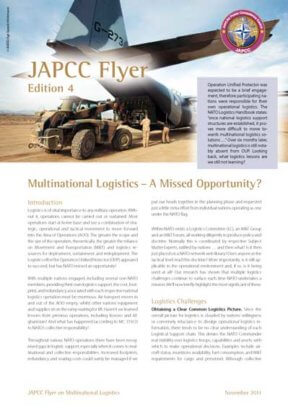Introduction
Logistics is of vital importance to any military operation. Without it, operations cannot be carried out or sustained. Most operations start at home base and use a combination of strategic, operational and tactical movement to move forward into the Area of Operations (AOO). The greater the scope and the size of the operation, theoretically, the greater the reliance on Movement and Transportation (M&T) and logistics resources for deployment, sustainment and redeployment. The Logistics effort for Operation Unified Protector (OUP) appeared to succeed, but has NATO missed an opportunity?
With multiple nations engaged, including several non-NATO members, providing their own logistics support, the cost, footprint, and redundancy associated with each respective national logistics operation must be enormous. Air transport moves in and out of the AOO empty, whilst other nations’ equipment and supplies sit on the ramp waiting for lift. Haven’t we learned lessons from previous operations, including Kosovo and Afghanistan? And what has happened (according to MC 319 / 2) to NATO’s collective responsibility?
Throughout various NATO operations there have been recognised gaps in logistic support, especially when it comes to multinational and collective responsibilities. Increased footprints, redundancy and soaring costs could surely be managed if we put our heads together in the planning phase and requested just a little extra effort from individual nations operating as one under the NATO flag.
Within NATO exists a Logistics Committee (LC), an M&T Group and an M&T Forum, all working diligently to produce policy and doctrine. Normally this is coordinated by respective Subject Matter Experts, ratified by nations … and then what? Is it then just placed on a NATO network web library? Does anyone at the tactical level read this doctrine? More importantly, is it still applicable in the operational environment and, if so, is it being used at all? Our research has shown that multiple logistics challenges continue to surface each time NATO undertakes a mission. We’ll now briefly highlight the most significant of these.
Logistics Challenges
Obtaining a Clear Common Logistics Picture. Since the overall picture for logistics is clouded by nations’ willingness or conversely reluctance to divulge operational logistics information, there tends to be no clear understanding of each Logistical Support chain. This denies the NATO Commander real visibility over logistics troops, capabilities and assets, with which to make operational decisions. Examples include aircraft status, munitions availability, fuel consumption, and M&T requirements for cargo and personnel. Although collective responsibility was introduced in 2003, each nation participating in OUP was responsible for its own logistic support. Nations should provide NATO Commanders (LCC, ACC and MCC) with the logistic C2 authority and capabilities they require to execute their responsibilities throughout all phases of an operation. In principle, military operations will be executed jointly in association with other components, to include maritime and land. An integrated joint operation assumes that member nations are familiar with each other’s capabilities and / or limitations, and comprehend the basic principles of each other’s doctrine and procedures. There needs to be a balance between the most assured and most cost-effective ways of delivering support, an optimised logistic footprint, and pursuit of the greatest possible standardisation and interoperability.
Interoperability versus National Sovereignty. National Sovereignty plays a huge role in the willingness of a nation to report logistics status. NATO nations contributing to OUP only provide visibility of what they think NATO needs to see. No single nation has the common logistical picture. Individual nations may not see the ‘big picture’ and recognise cost savings and efficiencies, thereby reducing redundancy. Interoperability is key, but nations want to maintain their sovereignty as well, and therefore tend to work independently.
National Logistics Non-Reporting (NR). It has been noted that no common logistical picture exists. This is perpetuated by the relatively high percentage (in proportion to contributing countries) of NR for Logistics, M&T, Infrastructure and Support. Oddly, not even the NATO Commander has the means of enforcing logistics reporting. This effectively allows even the larger NATO nations to continue operating without reporting. How then, are smaller countries expected to report?
Applying NATO Logistics Doctrine at the Operational Level. NATO’s Logistics Functional Area System (LOGFAS) is the NATO tool for logistics planning and reporting, discussed in almost every NATO Logistics publication, yet completely absent from the operational environment. Nations are not compelled to use this and instead employ their own systems, reducing commanders’ situational awareness, which may hinder critical decision making. Does the tool no longer fit the purpose?
Final Thoughts
In March 2011, a NATO Task Force (TF) on Building Capabilities through Multinational and Innovative Approaches was developed, based on Government decisions at NATO’s Lisbon Summit. The TF supports cooperative capabilities development, getting the best return on defence investment, thereby increasing efficiencies. There is a renewed sense of urgency to make multinational approaches a priority, improving cooperation to get better value for money. So why, in this environment, do we choose to ignore multinational logistics doctrine and tools developed / paid for to improve efficiency and visibility to the NATO Commander? If NATO worked more as a team and assumed a collective posture toward a shared goal, NATO could reduce the costs, redundancies and footprint, whilst increasing the efficiency and effectiveness of NATO logistics.
What is the correct balance of National, Bi-lateral, and Multinational Logistics? The Alliance certainly seems to be missing an opportunity to work together within existing doctrine by providing full disclosure of the logistics operational picture at the right level. This would give NATO a common overall logistics picture to effectively run the campaign. Perhaps the best solution is to look back, via scrutiny of existing operational logistics doctrine and Joint Lessons Learned. This will allow us to reset logistics planning for the next NATO-led conflict and update, change or delete doctrine as applied to operational realities.
We hope that this Flyer will generate discussion, thoughts and ideas with respect to multinational logistics operations. Your feedback is vitally important to future research and a forthcoming JAPCC Journal article discussing these logistics challenges in more detail.











